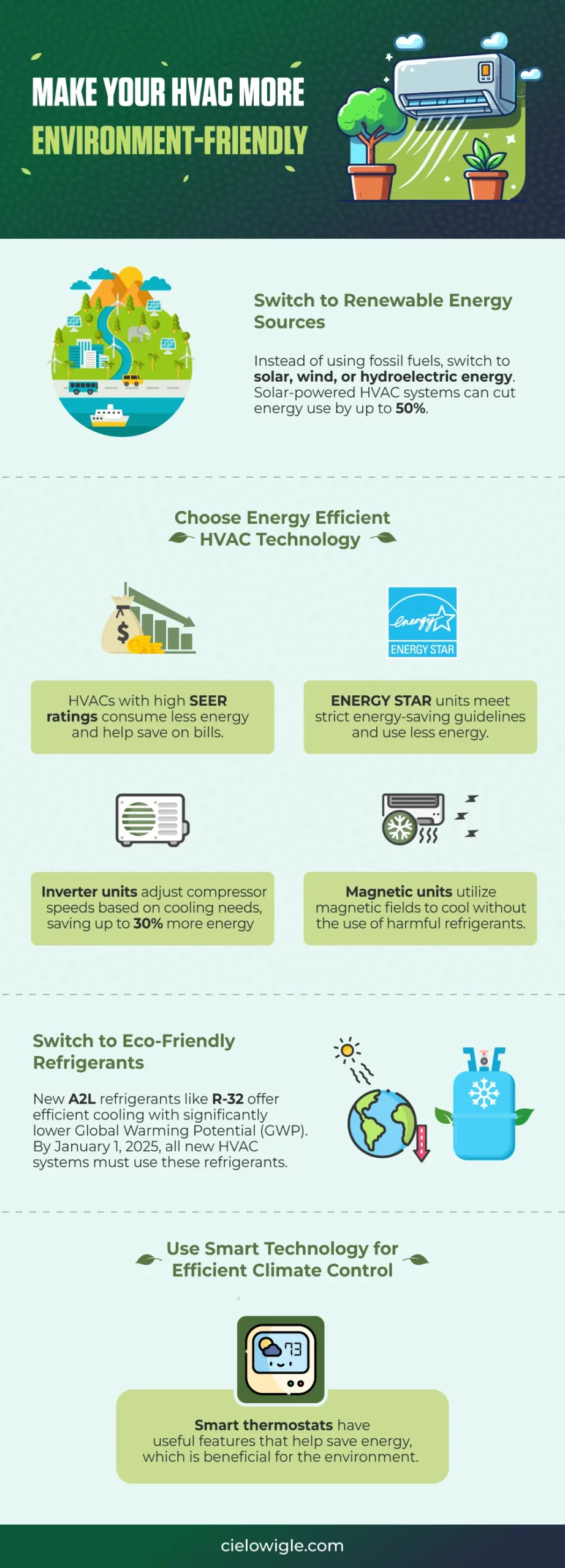
Key Takeaways
- Traditional ACs consume a lot of energy and contribute heavily to greenhouse gas emissions.
- In the US, 117 million metric tons of carbon dioxide are released annually due to AC usage.
- Switching to energy-efficient HVACs, smart technology, and eco-friendly refrigerants can reduce environmental impact.
When it comes to maintaining your home climate, it has never been more essential to seek out sustainable and green air conditioning options that offer eco-friendly cooling and heating.
Traditional air conditioners may cool well, but they use a lot of energy and add to carbon emissions. While fully eco-friendly air conditioning (that is carbon-neutral or uses 100% renewable energy) isn’t here yet, new technologies are helping move towards more sustainable options.
You can still reduce the adverse environmental impact by opting for environmentally safe air conditioners; let’s explore all the options in this blog.
Air Conditioning Usage & Environmental Concerns
As weather patterns shift around the year, with longer heat waves and high temperatures lasting into the fall, air conditioning has become essential for keeping homes cool and comfortable. However, with the increasing demand, the high energy consumption is driving up greenhouse gas emissions.
Approximately 6% of the electricity produced in the US is used by ACs. A substantial amount of this electricity comes from fossil fuel combustion, which releases an enormous amount of carbon dioxide, one of the biggest contributors to global warming. As a result, 117 million metric tons of carbon dioxide are released into the atmosphere annually.
Additionally, as air conditioning grows increasingly in demand worldwide, electricity grids are experiencing additional strain, leading to increased reliance on non-renewable energy sources.
R-410A vs. R-22 Freon
Another major problem with air conditioners is that they carry hydrofluorocarbons (HFCs), which are potent greenhouse gases. These gases trap heat in the atmosphere and are one of the most rapidly increasing contributors to pollution globally. By 2030, emissions from cooling appliances, such as air conditioners and refrigerators, are expected to rise even more.
Most air conditioners manufactured in the last five years utilize a refrigerant known as R-410A, which is less damaging to the environment compared to its predecessor, R-22 Freon. R-22 was known for depleting the ozone layer, which shields the Earth from harmful UV radiation. However, R-410A still has a major drawback: it is approximately 2,000 times more potent at trapping heat than carbon dioxide, a major greenhouse gas.
Due to its harmful composition, R-22 was gradually phased out beginning in 2010 and was totally banned by January 2020. If your air conditioner was made before 2010, it may still use R-22. This refrigerant will remain available for some time as it can be recycled from older systems.
Air conditioners keep your home comfortable, but they also contribute to warming the planet. As more people use air conditioning, up to three-quarters of the world’s population may encounter deadly heat and humidity by the end of the century.
Green HVAC: How to Make Your AC More Eco-Friendly
Here are some ways to make your air conditioning more eco-friendly and environmentally clean:

-
Reliance on Renewable Energy
Using renewable energy to power air conditioning is a significant step in making cooling systems more sustainable. Instead of using fossil fuels, air conditioners can be operated using solar, wind, or hydroelectric energy. This helps to reduce the amount of pollution that contributes to climate change.
Solar-powered air conditioning is an excellent example. It absorbs energy from the sun to cool your home. This means you won’t be using as much electricity from the power grid, which could reduce your energy use by up to 50%, depending on where you live. While you may still require some power from the grid, the huge reduction in usage can result in significant savings on your cooling expenses.
-
Choose Energy-Efficient HVAC Technology
When purchasing an air conditioner, look for one with a high SEER rating (seasonal energy efficiency ratio). SEER indicates how much cooling the air conditioner provides compared to how much energy it consumes. The higher the SEER, the less energy your AC operates on, resulting in lower electricity bills and less pollution. In 2023, new standards require air conditioners in the northern US to have at least a 14 SEER, while those in the hotter southern US must have at least a 15 SEER.
Additionally, look for air conditioners with the ENERGY STAR label. It means they comply with the US government’s energy-saving standards. These models save energy and emit fewer greenhouse gases, making them better for the environment.
Another great option is an inverter air conditioner. These include smart compressors that can speed up or slow down according to how cool your home needs to be, saving up to 30% more energy than regular models that only operate at one pace.
Magnetic refrigeration is a new technology that rethinks conventional cooling systems. Andy Shu, an HVAC specialist at Zap Fixers, explains, “Magnetic cooling systems utilize magnetic fields to cool without the use of harmful chemical refrigerants.”
Though magnetic refrigeration shows great potential, it is still under development. However, it’s a technology worth watching in the next five to ten years.
-
Adoption of Eco-Friendly Refrigerants
Switching to less hazardous refrigerants is an important step in making air conditioning more environmentally friendly. Commonly used refrigerants, known as HFCs, have a high Global Warming Potential (GWP). Mehdi Khachani, CEO of Sunny Bliss Plumbing & Air Conditioning, says, “Traditional air conditioning systems, which rely on high-GWP refrigerants, contribute significantly to greenhouse gas emissions.”
A newer variant, R-32, is gaining popularity because it works really well and has a considerably lower GWP. This means it is better at cooling while consuming approximately 10% less electricity than previous refrigerants such as R-22. Furthermore, R-32 has a lower GWP, about one-third of the most common refrigerants, making it a more environmentally friendly option.
The US Environmental Protection Agency (EPA) has mandated that by January 1, 2025, all new residential and light commercial air conditioners and heat pumps utilize A2L-family refrigerants such as R-32. “Transitioning to these green technologies on a larger scale could make a substantial difference in reducing global carbon emissions,” Khachani adds.
-
Smart Technology for Efficient Climate Control
Smart mini-split thermostats and smart thermostats for central HVAC systems have useful features that help save energy, which is beneficial for the environment. One handy feature is the ability to change the temperature in your home from anywhere using your phone. So, if your plans change and you are not home, you can turn down the AC to save energy. You may also control the thermostat to adjust temperatures during the day, such as raising it when you’re away, to reduce the amount of time your air conditioner runs and how much electricity it consumes.
Equip your HVAC system with smart features and achieve the perfect balance between comfort & savings.
Learn more
These smart home climate control products also provide thorough information on your air conditioning usage. This informs you where you can save more energy and lower your carbon footprint.
Expert Tips for a Greener Air Conditioning System
Here’s how you can adjust your daily routines and maintenance practices for air conditioning to be more environmentally friendly and reduce energy wastage.
-
Thermostat Setback Strategy
To save money on heating and cooling, consider lowering your thermostat by 7-10 degrees when you are not home. According to the Department of Energy, making this simple change, called the thermostat setback strategy, can help you save approximately 10% on your energy bills.
-
Choosing the Ideal Temperature Settings
The best temperature to set your thermostat when you are awake and at home is 68 degrees (in the winter) and 78 degrees (in the summer). This temperature keeps you comfortable while also conserving electricity, which benefits both your budget and the environment.
-
Clean Your Filters
Keeping your air filters clean is essential for efficient energy use. When filters become clogged with dust and debris, the system has to work harder to pull air through, leading to increased energy consumption.
-
Enhance Home Insulation
Improve the insulation in your home and seal any gaps to save energy on heating and cooling. Proper insulation in your attic, walls, and floors helps maintain a consistent temperature inside, allowing your HVAC system to work less hard. Sealing cracks or gaps around doors, windows, and ducts prevents air from escaping and makes your home more energy efficient.
Related: The Ultimate Guide to Types of Insulation
-
Regular HVAC Maintenance
Maintaining your HVAC system on a regular basis is essential for energy savings. Simple actions, including cleaning filters, inspecting ducts, and tuning up components, help your system function more efficiently and save energy. When your HVAC system is in good condition, it runs more smoothly, lasts longer, and you won’t have to worry about costly repairs later.
-
Replace or Repair
Consider whether it is best to replace your old HVAC unit rather than spend money on repairs that may result in higher long-term costs. Purchasing a new, energy-efficient system is sometimes a better and more environmentally friendly option than repeatedly repairing an outdated one.
Paving the Way for a Sustainable Future
Switching to green air conditioning is beneficial not just for your home’s energy use, but also for reducing your carbon footprint. You can take energy-saving measures, use eco-friendly refrigerants and smart HVAC controls to reduce your energy consumption and greenhouse gas emissions. These adjustments benefit the environment while also saving you money and making your home more comfortable in the long run.








